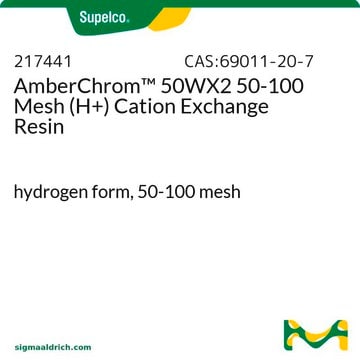567513-U
Discovery® HS F5 (5 µm) HPLC Columns
L × I.D. 5 cm × 4.6 mm, HPLC Column
Synonym(s):
Discovery Pentafluorophenyl PFP HPLC Column
About This Item
Recommended Products
product name
Discovery® HS F5 HPLC Column, 5 μm particle size, L × I.D. 5 cm × 4.6 mm
material
stainless steel column
Agency
suitable for USP L43
product line
Discovery®
feature
endcapped
manufacturer/tradename
Discovery®
packaging
1 ea of
extent of labeling
12% Carbon loading
parameter
≤70 °C temp. range
400 bar pressure (5801 psi)
technique(s)
HPLC: suitable
LC/MS: suitable
L × I.D.
5 cm × 4.6 mm
surface area
300 m2/g
surface coverage
4 μmol/m2
impurities
<10 ppm metals
matrix
silica gel, high purity, spherical particle platform
fully porous particle
matrix active group
PFP (pentafluorophenyl) phase
particle size
5 μm
pore size
120 Å
operating pH range
2-8
application(s)
food and beverages
separation technique
reversed phase
Looking for similar products? Visit Product Comparison Guide
General description
Generally, bases are retained longer on the HS F5 than on a C18. Increasing the organic content of a C18 separation 5 to 10 percent will generally provide similar retention on an HS F5. Results with other compounds are highly variable. However, it is generally true that solutes with log Po/w values less than 2.5 will be retained longer on HS F5 compared to a C18. The degree of difference is highly solute dependent.
Application
- Optimization and validation of a bioanalytical HPLC-UV technique for simultaneous determination of underivatized phenylalanine and tyrosine in the blood for phenylketonuria diagnosis and monitoring.: This study utilizes the Discovery® HS F5 HPLC Column to develop an HPLC-UV method for the simultaneous determination of phenylalanine and tyrosine in blood, significantly advancing the diagnostic and monitoring capabilities for phenylketonuria (Rabti et al., 2024).
- A new RP-HPLC method as an auxiliary tool for optimization of sample preparation procedures for tracing of PPCPs of different hydrophilicities.: Demonstrates the application of the Discovery® HS F5 HPLC Column in optimizing sample preparation techniques for the detection of pharmaceuticals and personal care products in environmental samples, enhancing the analysis of diverse hydrophilic compounds (Portillo-Castillo et al., 2021).
- "Heart-cut" bidimensional achiral-chiral liquid chromatography applied to the evaluation of stereoselective metabolism, in vivo biological activity and brain response to chiral drug candidates targeting the central nervous system.: Utilizes the Discovery® HS F5 HPLC Column in a novel bidimensional chromatographic setup to study the stereoselective metabolism of CNS-targeting chiral drugs, contributing to a deeper understanding of their pharmacological profiles (Battisti et al., 2016).
- HPLC method development, validation, and impurity characterization of a potent antitumor indenoisoquinoline, LMP776 (NSC 725776).: This research employs the Discovery® HS F5 HPLC Column for developing an HPLC method to identify and characterize impurities in the antitumor drug LMP776, ensuring drug purity and compliance with regulatory standards (Wang et al., 2016).
- Development studies on determination of preservatives decomposition products.: Showcases the application of the Discovery® HS F5 HPLC Column in the analysis of decomposition products of preservatives, enhancing the safety assessments of food and pharmaceutical products (Zabrzewska et al., 2014).
Features and Benefits
- Unique selectivity
- Similar retention to C18 (sometimes requires stronger mobile phase)
- Excellent peak shape
- Stable, low-bleed LC-MS separations
- Scalable separations from 3 to 10μm particle sizes
Legal Information
Application
guard cartridge
Choose from one of the most recent versions:
Already Own This Product?
Find documentation for the products that you have recently purchased in the Document Library.
Chromatograms
application for HPLCOur team of scientists has experience in all areas of research including Life Science, Material Science, Chemical Synthesis, Chromatography, Analytical and many others.
Contact Technical Service






